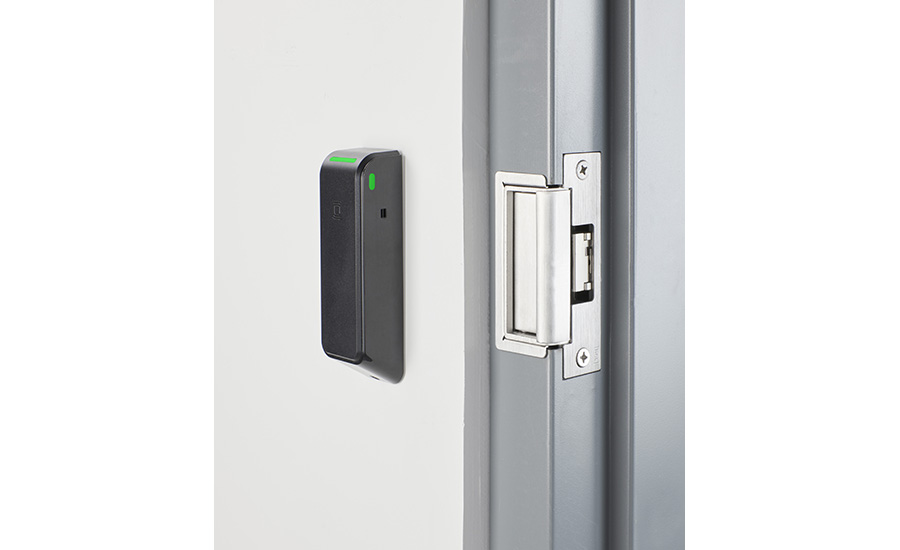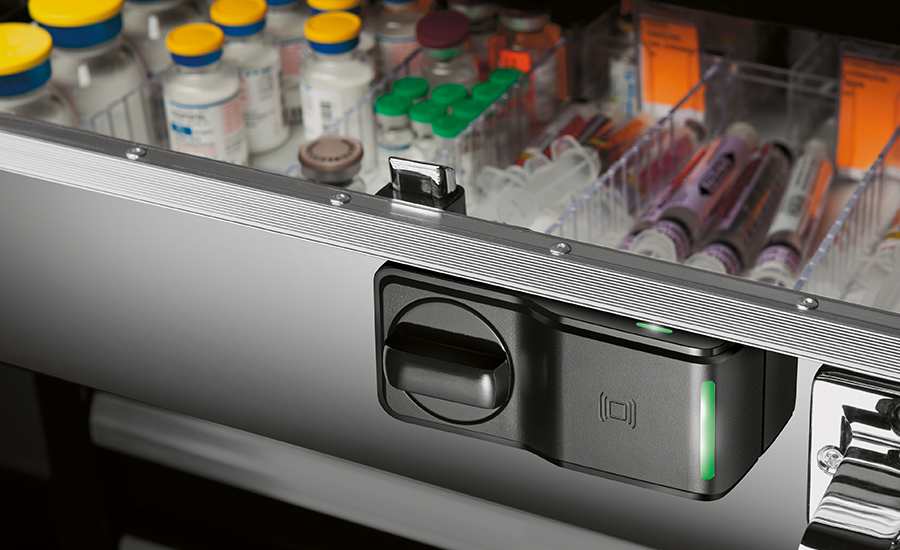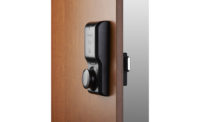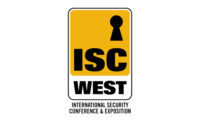Locks are at the heart of access control, and more users today are leaning on wireless lock solutions to secure not only their entrance doors, but a variety of other access points as well — in fact, as many as the customer and integrator can dream up.
Judging by unit value, security integrators and dealers are absolutely using wireless locks more than they did in the past, says Lester LaPierre, director of business development - electronic access control, ASSA ABLOY, New Haven, Conn. “The number and magnitude of wireless projects are phenomenal,” he says. “We’re not talking about hundreds of locks: we’re talking thousands at a time. The cost savings are so pronounced that it’s difficult for integrators to overlook wireless access solutions any longer. They need them to compete effectively.”
Although wireless locking devices are nothing new, some customers have hesitated to adopt them, often because of a bad experience when a wireless device was forced into a space not appropriate for the opening or need, says Jamie Lyn Callahan, channel sales manager, Allegion, Carmel, Ind. But as integrators and end users better understand where wireless locking devices do and don’t belong — and as more physical access control companies support locking solutions — consumer confidence in wireless locks has grown significantly.
“With the evolution of technology, there are a lot more capabilities in integrating [wireless locks] to complement an existing access control system,” says François Brouillet, product line manager at Genetec, Montreal.
Over the past five to seven years, Brouillet has observed increased customer demand for extending the use of wireless locks, either stand-alone or networked, with applications such as supply cabinets, medical cabinets, server racks, and other access points that still use keys and have never been managed wirelessly. Access control combinations can include securing exterior doors with traditional access control, and using wireless locks on interior doors, which typically require less security. “The new technology allows them to extend the reach of access control systems into other types of openings,” he says.
End users run the gamut, from college campuses and hotels to medical facilities; and secured access points can include supply closets, cabinets, and other points of ingress that may be difficult to get wire to. Wireless access control can provide customers with a cost-effective solution that is easily scalable, simple to use, and provides an audit trail for all doors and access points.
“Choosing wireless will help end users cut costs and secure more openings,” LaPierre says. Some products allow end users to do localized lockdowns or shelter-in-place type of applications. For example, a teacher in a classroom can press a button on the secure side of the lock, locking the door without having to leave the room and preventing anyone except those with master credentials from entering the room. Another end user benefit of wireless locks is that they will continue to function during a power outage, even if their panels and wired locks are not functioning, he adds.
Wireless access control solutions are especially popular in the small to medium business space, with adoption on the enterprise side slowly gaining traction as well, says Sheeladitya Karmakar, global offering leader, Honeywell Commercial Security, Atlanta. “Wireless access controls can help end users reduce costs while creating a safer entry point solution — a good example being the move from legacy controls like a physical access card to Bluetooth mobile recognition,” he says. “Moving to a wireless access solution offers integrators more flexibility in managing and assisting their end customers. The remote access allows more to be done with less; for example, less trips to a particular site as the problem can be resolved remotely and often quicker than if a physical visit were required.”

The wireless, keyless ABLOY BEAT padlock establishes connectivity via Bluetooth with a range up to 50 meters, and is secured with Seos credential technology. // IMAGE COURTESY OF ABLOY USA CRITICAL INFRASTRUCTURE
Wireless locks are also convenient and cost effective in securing remote locations, helping to extend the parameters of a facility without having to go through the whole infrastructure or run cables underground or along a building, as long as the opening can be reached through a wireless signal, Brouillot adds.
“With enterprise customers, we frequently see that they’re using wireless solutions to integrate smaller companies they’ve acquired into the larger, enterprise-wide security network,” Karmakar says. “As end users become more educated on the technology and its advantages, we’ll continue to see the demand increase for these solutions.”
The trend is likely to continue for both new and existing structures, says Jonathan Lach, vice president sales of Paxton Access, Greenville, S.C. Wireless locks and technology offer integrators more opportunity to expand an access control solution on a specific site, including adding locks to doors that may not have originally been a target for access control, he adds. “As older buildings are being updated with newer technology, we are seeing more adoption of access control, including wireless locks,” he says. “For new buildings, because wireless technology is so affordable and offers long-term value, we see this being used on more doors that previously may not have been included in the access control solution.”
For most integrators, wireless access control is a “go-to technology,” says Dries Pepler, vertical market manager - utilities for ABLOY USA Critical Infrastructure, Irvine, Texas. “But it’s all dependent on how they view what solution provides the greatest benefit to their customers. After using wireless access firsthand and successfully implementing it in their projects, they see these benefits are real and proven. Wireless access control can provide further control and security where previous technologies could not, especially in remote environments and areas without immediate access to power and internet connection points.”
New Tech, Collaboration & Challenges
Today’s chip sets and radio modules are superior to those from even five years ago, with better range, broader coverage area, and more energy efficiency, LaPierre says. This provides more flexibility for pairing locking devices to existing wireless access points for Wi-Fi solutions or dedicated hub infrastructure for Zigbee-based devices, he says. Modern wireless lock batteries last up to two years, and Wi-Fi locks have an internal database for up to 10,000 unique credentials, with access rights managed in the locks as well — no access panels, power supplies or battery back-up is needed. And Zigbee-based locks have a smart credential cache that can store up to 1,000 unique credentials and can also function when offline. “These improvements not only simplify deployments; they also enable more devices to communicate with the infrastructure, reducing overall deployment cost even further,” he adds.
On the credential side the wireless access control field is adopting many evolutions to current technology, such as BLE mobile credentials, custom encryption keys, and technology like Schlage’s No-Tour mobile access credentials, which immediately enable user access without requiring a separate visit to the opening, Callahan says.
Edge technology is especially prevalent on wireless locks, and wireless access control in general is rich in innovations such as smart readers offering mobile credentials recognition, says Karmakar of Honeywell. “Replacing a full access system can be expensive,” he says. “Hence, one of the solutions that can be explored is the ability to enable a legacy reader for mobile credentials, which allows the system to use mobile features without the need to replace existing hardware.”
An example of this is ABLOY’s CLIQ and BEAT solutions. CLIQ is an electro-mechanical solution with power from the battery in the key to gain access to door cylinders and padlocks. CLIQ enables integrators to simply identify existing door hardware for access control and install a CLIQ cylinder, making it useful for retrofits. The wireless, keyless ABLOY BEAT is a one size, weatherproof padlock that can operate in extreme temperatures and has a field replaceable battery in the padlock that lasts up to five years, or 5,000 access cycles, Pepler says. The lock establishes connectivity via Bluetooth with a range up to 50 meters, and is secured with Seos credential technology. ABLOY BEAT is managed with secure software where administrators can create roles, permissions and schedules, and check audit trails, grant/revoke access rights, and more.
This wealth of new technology means that the form and factor of wireless locks are evolving — morphing into different variants of the same technology, but in different forms and shapes, Brouillet says. “Certain manufacturers we are working with are often using the same technology, but they’re respinning and bringing it to a different application,” he says. “Fundamentally the mechanism and the way it communicates remains the same.”
Just as essential to the growth of wireless access control is increased collaboration among industry players, especially manufacturers, Callahan says. Organizations like the FiRa Consortium, with membership that includes many major electronic security players, are promoting ultra-wideband (UWB) technology, which securely and accurately determines the relative position of peer devices and can operate with line of sight at up to 200 meters, even in congested multi-path signal environments. Another example is the Cloud Security Alliance’s access control working group, which oversees Matter, Google’s smart home standard. “These collaborations are critically important because they will improve the experience for all stakeholders,” Callahan says. “This concentrated effort from many to move together toward a common goal will ultimately make us all stronger.”
In spite of these advantages, integrators still face challenges in convincing some end users to adopt cloud-based access control solutions, Karmakar of Honeywell says. “Many in the security industry, especially at the enterprise level, are still wary of ‘exposing’ their security systems to the ‘outside world,’” he says. “To help alleviate some of these concerns, it’s important to educate them about the technical aspects of cybersecurity and explain that the benefits of implementing a cloud solution far outweigh the perceived vulnerabilities.”
LaPierre of ASSA ABLOY agrees. “There are some [customers] that recognize the value and lead with it where appropriate, such as residence halls and IT rooms/closets. But the majority continue to lean toward traditional solutions such as wall readers, strikes, and other traditional methods for securing an opening. This has a lot to do with it being accustomed to working with what they know and what they are used to doing — which highlights the importance of [manufacturers] getting in front of integrators and end users and educating them on the benefits and ease of implementing wireless systems.”
He cites a prospect whose traditional access control system was offline so long, their battery backup ran out, leaving their openings unsecured. “Their last resort was to hire a guard service to ensure the security of the building. I casually mentioned that wireless locks would have remained secured in their scenario and they were stunned.”
A big part of the education process is to encourage end users to work with trusted advisors including consultants, integrators, locksmiths, and manufacturers for solutions, as well as doing more of their own research on available options, says Callahan of Allegion. “Total cost of ownership matters more than ever, and security is top of mind for many,” she says. “End users have a myriad of needs, and what is important to a K-12 facility is often not the same as a university, healthcare facility, retail space, or government institution. We must listen first before recommending products. Ultimately, the change to end users advocating more vocally for their needs helps us match them with the solutions most appropriate for them.”
Education is important on the integrator and dealer side as well. One of the biggest challenges for them is the need for education and training from manufacturers on correct installation methods, says Brouillot of Genetec. “The locksmith knowledge (for wireless locks) is different from traditional access control installer knowledge,” he says. Not only are wireless locks far different from traditional locks, but wireless signals can be complex. “When a lock is hardwired, there’s a signal, and you’re good to go,” he says. “Wireless is trickier; it may look good at installation, but as people move into a building, enabling wireless and using Bluetooth, there can be noise on the wireless spectrum that will affect the performance of wireless locks. It’s important to understand how sound waves are propagating through the building so we can put the hubs in the right place. It’s a science of its own, and a learning curve for installers.”
Lach of Paxton points out the additional challenge of using multiple technologies from different manufacturers in a single building, sometimes causing fear of having to integrate different systems. “We see this all the time, and having many solutions not integrated together loses the value of an access control solution,” he says. “Having wired access control, video intercom, and a wireless solution all by one manufacturer takes the complexity out of the equation and if something does go wrong it’s just one phone call.”
Security integrators are also faced with finding wireless lock solutions that are durable, can operate in extreme weather conditions, and are reliable, says Shayne Spears, ABLOY USA Critical Infrastructure’s vertical marketing manager – national accounts for oil & gas and mining. “Understanding the differences and what specific technologies are used in various wireless and keyless offerings is important,” he says. “Our team loves proving the effectiveness of our solutions, and we also pride ourselves on being a trusted advisor for our partners.”

More integrators and end users are adding wireless locks to secure internal access points such as drawers and cabinets, such as this HES K100 Series cabinet lock in a healthcare setting. // IMAGE COURTESY OF ASSA ABLOY
Words of Wisdom
So what’s the best advice for security dealers and integrators that want to increase customer awareness about wireless locks?
“Look behind the traditional door (and) … know how to ask questions,” Brouillet says. “It all comes back to understanding the business end for customers; that’s what integrators are good at. Take requirements from end users and see what their other pain points are, then propose technology that the customer might not have thought about before.” For example, if an integrator walks into the customer’s building and sees locked cabinets, ask the customer how they should be secured, what sort of information is housed there, and what are the risks and liabilities of allowing that information into unwanted hands? “You could be uncovering opportunities to expand your business,” he says.
Lach adds, “Always ask about the closet door, or other doors that the end customer may not have thought of for access control. Have enough bridges for the wireless locks to bind with. Take into consideration the building size, number of floors, and Wi-Fi interference in the walls and ceiling that positively or negatively affect the lock connecting to the bridge.”
“Look behind the traditional door (and) … know how to ask questions. It all comes back to understanding the business end for customers; that’s what integrators are good at.” - Francois Brouillet, Genetec
This questioning must also take into account the customer’s full IT environment before proposing a solution, Karmakar adds. “We want to take in the full picture to provide the best long-term solution.”
Once this is established, integrators should sit down with their manufacturer partners to craft a strategy that will help the customer deploy a cost-effective and efficient solution, which is particularly important when retrofitting a legacy solution, Karmakar says.
This includes getting the appropriate training for your technicians, so they understand the capabilities of wireless locks and the benefits they can provide the end user, LaPierre stresses. For example, Zigbee-based wireless locks can communicate every five seconds to the head end system, making them ideal for remote unlock and lockdown applications, and Wi-Fi locks include a privacy mode button on the back of the lock, which can be used for localized lockdowns.
“ “For the majority (of integrators), wireless access is a go-to technology, but it’s all dependent on how they view what solution provides the greatest benefit to their customers. - Dries Pepler, ABLOY USA Critical Infrastructure
Callahan urges integrators to reach out to their manufacturers for help and training during the planning process. “We want to see you succeed,” she says. “Ask the manufacturer what tools, services, and resources are available for your team and for your customers to make the presale, site survey, installation, and post installation experiences positive. Set expectations up front and ask the manufacturer what you can expect from them at each stage.”
This should include working with the manufacturer of the locking device and the selected access control manufacturer to “test drive” the products and learn the full, integrated solution at the right pace for your team, Karmakar says. “With all the different types of wireless locking solutions and providers out there, this leads to higher satisfaction, because you experience firsthand the capabilities and limitations of the solution and aren’t just sold on a concept.”
Brouillet agrees on the importance of training for integrators to succeed in wireless lock sales. “Pick one type of technology and get trained on it so you know it in and out,” he suggests. “That way you will spend less time deploying and feel more comfortable proposing to customers.”
It’s also important for both integrators and end users to understand the cybersecurity impacts and requirements, Karmakar notes. “With the constant evolution of cyber threats and buildings becoming more connected, how to mitigate cyber risks is a critical conversation that needs to happen.”
Finally, always keep in mind that wireless access control, like any technology solution, must always be the most appropriate solution for the end user. “Remember that wireless access control is a great solution that can save time and money, create new revenue, bring you into new verticals, and enhance the user experience, but that it’s not the only solution and sometimes isn’t the right solution for an opening,” says Callahan. “The more experience you have with the products, the better you will be at understanding where there is opportunity for it on the sites you work with today and where you could take over new business tomorrow.”




